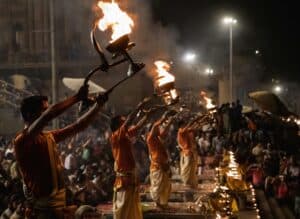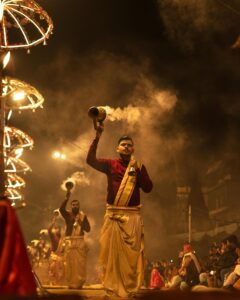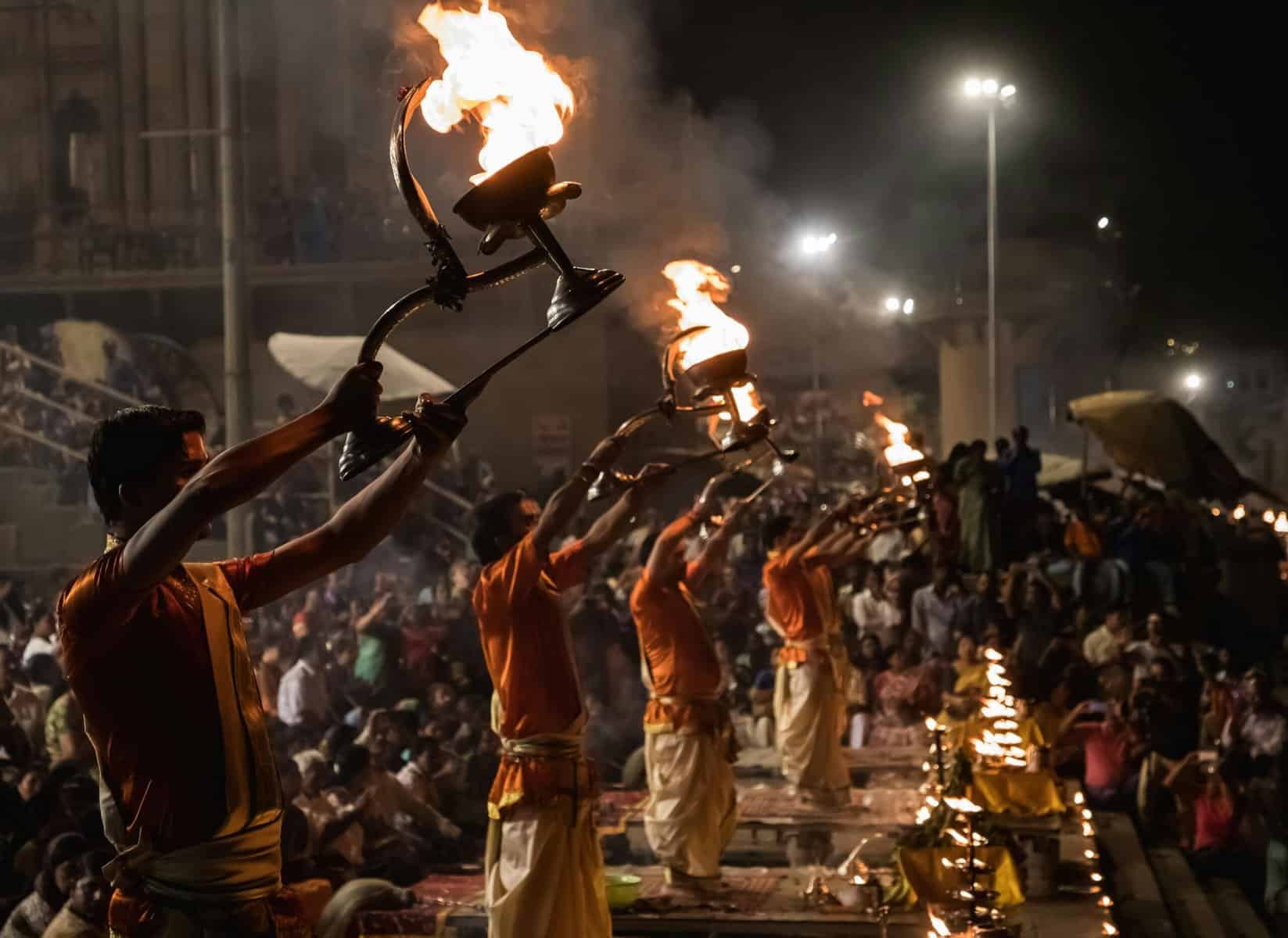Ganga Aarti: A Spiritual Spectacle Along the Banks of the Sacred Ganges


🕯️🌊 Introduction: Embracing Divine Reverence
In the heart of India, amidst the bustling city of Varanasi, lies a timeless tradition that beckons pilgrims and travelers from across the globe—the Ganga Aarti. This sacred ritual, performed daily along the banks of the revered Ganges River, offers a glimpse into the spiritual essence of India’s cultural tapestry.
🙏🏼🔥 The Ritual Unveiled: An Evening of Devotion
As the sun begins its descent, the atmosphere along the ghats of Varanasi becomes infused with anticipation. Devotees gather in droves, their faces illuminated by flickering oil lamps, eagerly awaiting the commencement of the Ganga Aarti. As dusk descends, the air resonates with the melodious chants of ancient hymns, invoking blessings upon the gathering.
🎶✨ A Symphony of Lights and Sound
As darkness envelops the city, the Ganga Aarti commences with a captivating display of lights and sound. Priests adorned in vibrant attire rhythmically sway to the melodious strains of devotional songs, their offerings of incense and flowers creating an aura of divine grace. Oil lamps, carefully arranged in intricate patterns, cast a mesmerizing glow upon the waters of the Ganges, symbolizing the eternal presence of the divine.
🌅🙌🏼 A Spiritual Awakening: Connecting with the Divine
For spectators, the Ganga Aarti transcends mere spectacle—it is a profound spiritual experience that touches the depths of the soul. As the prayers reverberate through the air, a sense of serenity descends upon the gathering, fostering an intimate connection with the sacred river and the divine forces it represents. Devotees offer their heartfelt prayers, seeking blessings for themselves and their loved ones, as the rhythmic chants echo across the waters, carrying their aspirations to the heavens above.
🌿🌺 Embracing Sacred Traditions: Preserving Heritage
The Ganga Aarti serves as a testament to India’s rich cultural heritage and unwavering devotion to spiritual pursuits. Passed down through generations, this sacred ritual embodies the essence of tradition and community, uniting people from all walks of life in a shared reverence for the divine. It stands as a symbol of hope, faith, and resilience, reminding us of the eternal cycle of life and the sacred bond between humanity and the cosmos.
🌟🌌 Conclusion: An Eternal Flame of Devotion
As the final notes of the Ganga Aarti fade into the night, a profound sense of peace pervades the atmosphere, leaving an indelible imprint upon the hearts of all who bear witness. The sacred river, illuminated by the flickering flames of devotion, continues to flow, carrying with it the hopes, dreams, and aspirations of millions. In the timeless ritual of the Ganga Aarti, we find solace, inspiration, and a profound reminder of the enduring power of faith and devotion.
May the sacred waters of the Ganges continue to bestow blessings upon all who seek solace and spiritual renewal along its hallowed shores.
FAQs (Frequently Asked Questions) About Ganga Aarti
🕯️ Q: What is Ganga Aarti?
A: Ganga Aarti is a sacred Hindu ritual performed along the banks of the Ganges River, particularly in cities like Varanasi and Haridwar. It involves the offering of prayers, hymns, and devotional songs to the river, accompanied by the lighting of oil lamps and incense.
🌊 Q: Where is Ganga Aarti performed?
A: Ganga Aarti is predominantly performed in Varanasi, also known as Kashi, along the ghats (riverfront steps) of the Ganges River, notably at Dashashwamedh Ghat. However, similar rituals are also conducted in other cities along the Ganges, such as Haridwar and Rishikesh.
🔥 Q: What is the significance of Ganga Aarti?
A: Ganga Aarti holds immense spiritual significance for Hindus, as it is believed to honor and worship the sacred Ganges River, considered the holiest river in Hinduism. The ritual is a symbolic offering of prayers and gratitude to the river, seeking blessings for purification, prosperity, and spiritual liberation.
🙏🏼 Q: Who performs Ganga Aarti?
A: Trained priests and pandits perform Ganga Aarti, following traditional Vedic rituals and hymns. These priests conduct the ceremony with utmost reverence and devotion, adhering to ancient customs and practices passed down through generations.
🎶 Q: When is Ganga Aarti performed?
A: Ganga Aarti is typically performed twice daily, at dawn and dusk. The evening Aarti, known as Sandhya Aarti, is the most popular, drawing large crowds of devotees and tourists who gather to witness the spectacle of lights, music, and prayers.
🌅 Q: Can anyone participate in Ganga Aarti?
A: Yes, Ganga Aarti is open to all, regardless of religious affiliation. Visitors are welcome to observe the ritual from designated viewing areas along the ghats. However, it is essential to respect the sanctity of the ceremony and follow the instructions of the priests and authorities present.
🌿 Q: Is photography allowed during Ganga Aarti?
A: Photography is generally permitted during Ganga Aarti, but it’s essential to be respectful of the sanctity of the ritual and avoid disrupting the proceedings. Flash photography and loud noises should be avoided out of reverence for the sacred atmosphere.
🌟 Q: What should I wear when attending Ganga Aarti?
A: Visitors are advised to dress modestly and conservatively when attending Ganga Aarti, out of respect for the religious significance of the ceremony. Comfortable attire suitable for sitting on the ground and walking along the ghats is recommended.
🚣♂️ Q: Are there any boat rides available during Ganga Aarti?
A: Yes, boat rides are available on the Ganges River during Ganga Aarti, offering a unique perspective of the ritual from the water. Visitors can opt for guided boat tours or private boat rides to witness the ceremony from a different vantage point.
🌺 Q: How can I learn more about Ganga Aarti?
A: To learn more about Ganga Aarti and its significance, visitors can consult local guides, attend informational sessions, or explore online resources and documentaries dedicated to Hindu rituals and traditions. Additionally, interacting with local priests and devotees can provide valuable insights into the spiritual aspects of the ceremony.

